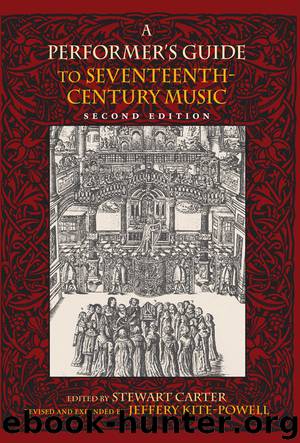A Performer's Guide to Seventeenth-Century Music by Kite-Powell Jeffery Carter Stewart

Author:Kite-Powell, Jeffery, Carter, Stewart
Language: eng
Format: epub
Publisher: Indiana University Press
Example 14.1a. Johann Jakob Froberger, Toccata 1 in A Minor, mm. 1–3.
Example 14.1b. Louis Couperin, Prélude à l'imitation de Mr. Froberger (excerpt).
Both Louis Couperin and Froberger also wrote poignant tombeaux for harpsichord on the death of their mutual friend Sieur de Blancrocher (i.e., Charles Fleury). It is, in fact, as a harpsichord composer that Froberger made his most significant contribution to seventeenth-century keyboard music. Pieces such as his Lamento sopra la dolorosa perdita della…Ferdinand IV and the Tombeau plumb the depths of the expressive potential of the instrument, and Froberger was also responsible for the establishment of the harpsichord suite in Europe. His early works in this genre consisted of allemande, courante, and sarabande, but the gigue was soon included, appearing directly after the allemande.
England
The great Elizabethan tradition of keyboard composition as represented by composers such as William Byrd, Orlando Gibbons, and Giles Farnaby was not sustained during much of the seventeenth century. The establishment of the Commonwealth ultimately suppressed musical growth in England, particularly that of the organ, and this was admittedly not a rich period of keyboard composition in the British Isles. For example, Bull left his native country because of this unfavorable musical climate and ultimately settled in Antwerp in 1613, to the delight of Sweelinck but to the detriment of the English.
Keyboard composition was revived in England after the Restoration, but with thinner textures, simpler melodies, and fewer dances of the old style. For example, Elizabeth Rogers’ Virginal Book (1656/57) contains no pavanes and galliards, but rather simple binary almans and corants. The French influence is also now felt more strongly in English music from this period, and the suite begins to take prominence.35 Thomas Mace described the genre in 1676:
A Sett, or a Suit of Lessons…may be of any Number…The First always should begin [with] which we call a Prealudium or Praelude. Then, Allmaine, Ayre, Coranto, Seraband, Toy, or what you please, provided They be all in the same Key.…36
Download
This site does not store any files on its server. We only index and link to content provided by other sites. Please contact the content providers to delete copyright contents if any and email us, we'll remove relevant links or contents immediately.
| Biographies | Business |
| History & Criticism | Instruments |
| Musical Genres | Recording & Sound |
| Reference | Songbooks |
| Theory, Composition & Performance |
The Goal (Off-Campus #4) by Elle Kennedy(12456)
Kathy Andrews Collection by Kathy Andrews(10561)
Diary of a Player by Brad Paisley(6872)
What Does This Button Do? by Bruce Dickinson(5538)
Assassin’s Fate by Robin Hobb(5256)
Big Little Lies by Liane Moriarty(4894)
Pale Blue Dot by Carl Sagan(4021)
Sticky Fingers by Joe Hagan(3459)
The Heroin Diaries by Nikki Sixx(2943)
The Death of the Heart by Elizabeth Bowen(2912)
Beneath These Shadows by Meghan March(2731)
The Help by Kathryn Stockett(2711)
Confessions of a Video Vixen by Karrine Steffans(2686)
How Music Works by David Byrne(2541)
Jam by Jam (epub)(2499)
Harry Potter 4 - Harry Potter and The Goblet of Fire by J.K.Rowling(2423)
Strange Fascination: David Bowie: The Definitive Story by David Buckley(2371)
Petty: The Biography by Warren Zanes(2242)
Darker Than the Deepest Sea by Trevor Dann(2215)
